A) more dense air rises at the surface
B) less dense air sinks at the surface
C) less dense air flows in to replace the rising air
D) denser air flows in to replace the rising air
Correct Answer

verified
Correct Answer
verified
Multiple Choice
If a gas cools under constant pressure, the molecules within it have ______ kinetic energy (motions) and can therefore _______________.
A) less; be packed into a smaller volume
B) less; be packed into a larger volume
C) more; be packed into a larger volume
D) more; be packed into a smaller volume
Correct Answer

verified
Correct Answer
verified
Multiple Choice
This diagram features a 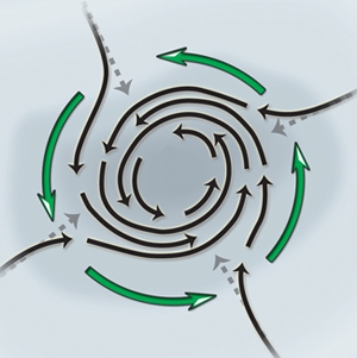
A) cyclone, southern hemisphere.
B) anticyclone, northern hemisphere.
C) cyclone, northern hemisphere.
D) anticyclone, southern hemisphere.
Correct Answer

verified
Correct Answer
verified
Multiple Choice
What would be the correct sequence of prevailing winds on a transect from the North Pole to the South Pole?
A) westerly, easterly, southeast, northeast, easterly, westerly
B) westerly, easterly, northeast, southeast, easterly, westerly
C) easterly, westerly, southeast, northeast, westerly, easterly
D) easterly, westerly, northeast, southeast, westerly, easterly
Correct Answer

verified
Correct Answer
verified
Multiple Choice
A true difference between north and south polar areas is.
A) North Pole is over ocean, South Pole is over land.
B) High pressure located over North Pole low pressure over South Pole.
C) low pressure located over North Pole, high pressure over South Pole.
D) South Pole is over ocean, North Pole over land.
Correct Answer

verified
Correct Answer
verified
Multiple Choice
Which of the following best describes air circulation at high latitudes?
A) Cold dense air rises at the poles, flows outward away from poles, and rises between 60 and 45 degrees latitude.
B) Cold dense air sinks at the poles, flows outward away from poles, and rises between 60 and 45 degrees latitude.
C) Cold dense air sinks at poles, flows outward away from poles, and sinks between 60 and 45 degrees latitude.
D) Cold dense air rises at the poles, flows outward away from the poles and sinks between 60 and 45 degrees latitude.
Correct Answer

verified
Correct Answer
verified
Multiple Choice
At which location would the Coriolis force deflection be the least? 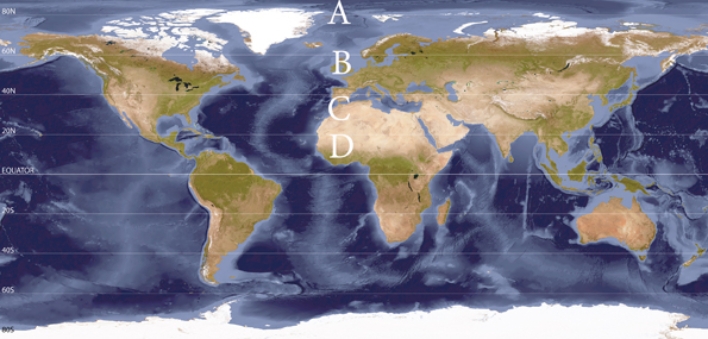
A) A
B) B
C) C
D) D
Correct Answer

verified
Correct Answer
verified
Multiple Choice
In the southern hemisphere objects are deflected to the
A) right, but based on objects moving to the north or south only.
B) left, but based on objects moving to the north or south only.
C) right, irrespective of which way it is moving.
D) left, irrespective of which way it is moving.
Correct Answer

verified
Correct Answer
verified
Multiple Choice
All of the following is true regarding the flow of air aloft in the mid-latitudes EXCEPT.
A) west to east flow.
B) east to west flow.
C) wind speed aloft is greater than wind speed at surface.
D) circulation is restricted to the troposphere.
Correct Answer

verified
Correct Answer
verified
Multiple Choice
The isohypses portrayed here show. 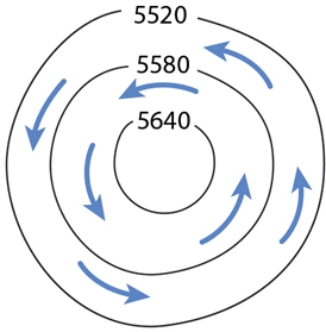
A) high pressure, northern hemisphere.
B) low pressure, southern hemisphere.
C) high pressure, southern hemisphere.
D) low pressure, northern hemisphere.
Correct Answer

verified
C
Correct Answer
verified
Multiple Choice
The Hadley cell is characterized by.
A) low pressure, sinking air over the equator, high pressure, rising air at 30N and 30S.
B) high pressure, sinking air over the equator, low pressure, rising air at 30N and 30S.
C) low pressure, rising air over the equator, high pressure, sinking air at 30N and 30S.
D) high pressure, rising air over the equator, low pressure, sinking air at 30N and 30S.
Correct Answer

verified
C
Correct Answer
verified
Multiple Choice
Which of the following locations shows the best development of a Rossby wave ridge? 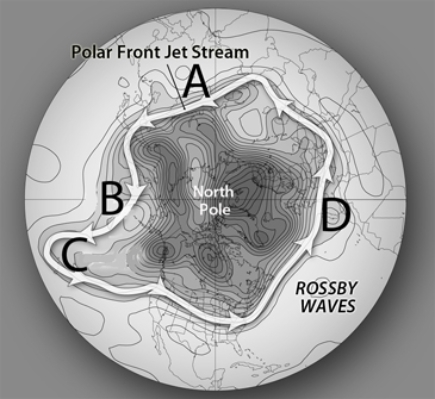
A) A
B) B
C) C
D) D
Correct Answer

verified
Correct Answer
verified
Multiple Choice
The dot on this map represents Missouri.Based on your knowledge of the anticyclone's wind direction, how would temperatures change between 2/11/2012 and 2/13/2012? 
A) cooler then warmer
B) warmer then cooler
C) cold then colder
D) temperatures wouldn't change
Correct Answer

verified
Correct Answer
verified
Multiple Choice
All of the following are true regarding the monsoon in India and Southeast Asia EXCEPT.
A) creates a winter dry season.
B) appears in art, music, and architecture.
C) begins in the north and moves south.
D) greens out vegetation in the summer.
Correct Answer

verified
C
Correct Answer
verified
Multiple Choice
In accordance with Boyle's Law, a gas under constant temperature will ____________ in volume when the pressure is ____________.
A) increase; increased
B) decrease; increased
C) decrease; decreased
D) keep the same volume regardless of pressure
Correct Answer

verified
Correct Answer
verified
Multiple Choice
Which of the following circulation patterns is characteristic of a cyclone or low pressure in the Southern Hemisphere?
A) air flowing inward, counterclockwise
B) air flowing outward, counterclockwise
C) air flowing inward, clockwise
D) air flowing outward, clockwise
Correct Answer

verified
Correct Answer
verified
Multiple Choice
Which properly describes surface winds within the Tropics?
A) inconsistent winds, called the doldrums which last for most of the year
B) winds blowing from southwest to northeast in the northern hemisphere, winds blowing northwest to southeast in the southern hemisphere
C) winds blowing from northwest to southeast in the northern hemisphere, winds blowing southwest to northeast in the southern hemisphere
D) winds blowing from northeast to southwest in the northern hemisphere, winds blowing southeast to northwest in the southern hemisphere
Correct Answer

verified
Correct Answer
verified
Multiple Choice
Which wind belt is located at letter D? 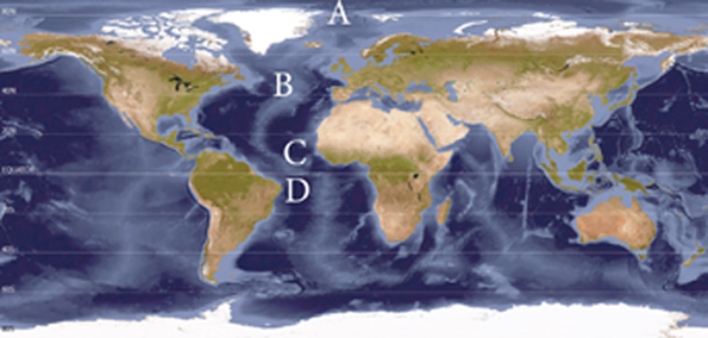
A) Polar Easterlies
B) Westerlies
C) Northeast Trade Winds
D) Southeast Trade Winds
Correct Answer

verified
Correct Answer
verified
Multiple Choice
The isohypses portrayed here show. 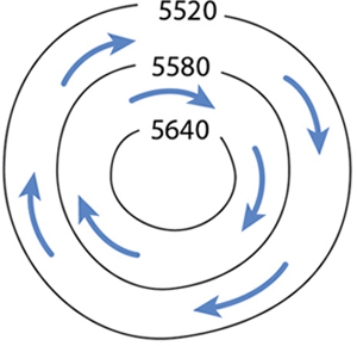
A) high pressure, northern hemisphere.
B) low pressure, northern hemisphere.
C) low pressure, southern hemisphere.
D) high pressure, southern hemisphere.
Correct Answer

verified
Correct Answer
verified
Multiple Choice
A mountain or katabatic breeze is created when
A) air from lower elevations is heated more efficiently and rises, creating an upslope breeze.
B) air from higher elevations is cooled more efficiently and sinks, creating a downslope breeze.
C) air from lower elevations is cooled more efficiently and rises, creating an upslope breeze.
D) air from higher elevations is heated more efficiently and sinks, creating a downslope breeze.
Correct Answer

verified
Correct Answer
verified
Showing 1 - 20 of 75
Related Exams